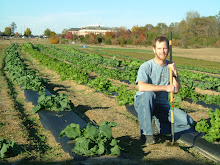This field of rye is the residue of my winter cover crop, measuring about 3.5 tons per acre.
 It was killed without the use of herbicides using crimp-and-roll equipment, which is why all the rye is lying in the same direction.
It was killed without the use of herbicides using crimp-and-roll equipment, which is why all the rye is lying in the same direction.
In order to plant in a no-till field, all the residue must lie in the same direction so that the stalks don't clog up the tillage equipment.

 It was killed without the use of herbicides using crimp-and-roll equipment, which is why all the rye is lying in the same direction.
It was killed without the use of herbicides using crimp-and-roll equipment, which is why all the rye is lying in the same direction.In order to plant in a no-till field, all the residue must lie in the same direction so that the stalks don't clog up the tillage equipment.

This is a decomposition experiment.
Nylon mesh litterbags are packed with samples of organic mulches, then either buried (to represent conventional tillage) or placed on the surface (to represent no-till).

The bags are retrieved periodically and the contents are analyzed for mass and nutrient content.
Knowing the different nutrient release rates between conventional and no till will inform farmers about how and when nutrients are released from the mulches and available to the plants.
Nylon mesh litterbags are packed with samples of organic mulches, then either buried (to represent conventional tillage) or placed on the surface (to represent no-till).

The bags are retrieved periodically and the contents are analyzed for mass and nutrient content.
Knowing the different nutrient release rates between conventional and no till will inform farmers about how and when nutrients are released from the mulches and available to the plants.




3 comments:
Very interesting. The future of farming! But what will happen to the Plowing Championships? They will have to start the Crimp and Roll Championships instead.
That looks so deceptively simple.
I have no doubt that concept will play an important role in farming in a future where resources are scarce and irrigation and fertilisers etc. are major alternative costs/inputs.
Wow, interesting stuff. I presume crimp-and-roll equipment is the standard gear for creating crop circles?
Post a Comment